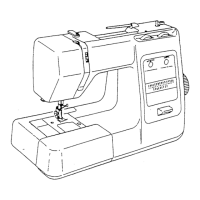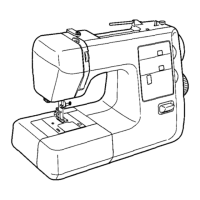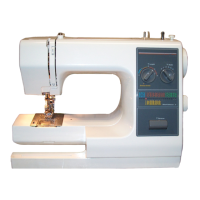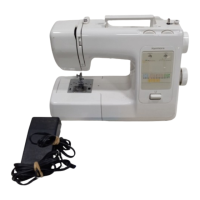Do you have a question about the Kenmore 385.17124 and is the answer not in the manual?
Critical safety warnings regarding electrical hazards and general operation.
Summary of warranty coverage and key machine specifications.
Instructions for operating the machine and essential maintenance tips.
Guidance on diagnosing and resolving common operational problems.
Critical safety warnings related to electrical hazards and shock prevention.
General safety precautions to prevent burns, fire, electric shock, or injury.
Details of the 25-year warranty for the sewing machine head.
Details of the 2-year warranty for electrical and electronic components.
Details of the 90-day warranty for parts and mechanical adjustments.
Information on how and where to obtain warranty service.
Details on sewing speed, stitch length, and stitch width capabilities.
Information about the physical size and weight of the sewing machine.
Information on available carrying cases and cabinets for the sewing machine.
Diagram identifying all the numbered parts of the sewing machine.
Information on how to order repair parts, including required details.
List of available accessories with their corresponding part numbers and descriptions.
Step-by-step guide on how to connect the sewing machine to the electrical power source.
Important safety tips to follow while operating the sewing machine.
Guidance on operating the machine and information about polarized plugs.
Explanation of how to control the sewing speed using the foot control.
How to adjust the pressure of the presser foot for different fabrics.
How to use the presser foot lifter to raise and lower the presser foot.
Explanation of the built-in thread cutter function.
Location and use of the accessory box for storing sewing items.
Step-by-step instructions for replacing the sewing machine needle.
Procedure for removing and attaching the foot holder.
Instructions on how to remove and attach different presser feet.
Details on common presser feet: Zigzag, Straight Stitch, and Sliding Buttonhole.
Information on Zipper, Satin Stitch, and Automatic Buttonhole feet.
Guidelines for selecting needle size and thread type for various fabrics.
Information on special needles (denim, topstitching, leather) and thread quality.
Procedure to remove the hook cover plate for bobbin access.
Instructions for using the horizontal spool pin for winding thread.
How to use the additional spool pin for bobbin winding and twin needle sewing.
Detailed steps for winding thread onto the bobbin using the machine.
How to adjust the stopper to control the amount of thread on the bobbin.
Correct method for placing the bobbin in the bobbin holder, ensuring thread direction.
Procedure for reattaching the hook cover plate after inserting the bobbin.
Detailed steps for threading the upper thread through the machine guides.
How to bring the bobbin thread up to the needle area.
How to achieve correct needle thread tension for a straight stitch.
How to loosen needle thread tension when it is too tight.
How to tighten needle thread tension when it is too loose.
How to achieve correct needle thread tension for zigzag stitches.
How to adjust zigzag tension when it is too tight.
How to adjust zigzag tension when it is too loose.
How to adjust stitch length and select stretch stitches.
How to adjust stitch width for different stitches and twin needles.
Using the feed balancing dial to correct distorted stretch stitch patterns.
How to use the reverse stitch control for backstitching.
How to turn the stitch selector to choose stitches and understand the display.
Explanation of color-coded zones on the stitch length control for stitch selection.
Steps for starting and finishing seams using a straight stitch, including backstitching.
How to use the engraved seam guides on the needle plate for measuring seam width.
Technique for turning a square corner while sewing a straight stitch.
Explanation of topstitching for garment lines and settings required.
How to guide the fabric for even topstitching along edges.
Settings and steps for attaching the zipper foot correctly.
How to prepare fabric and start sewing the zipper opening.
Detailed steps for sewing the zipper, including folding and guiding the fabric.
Instructions for finishing the zipper seam, ensuring even folds.
How to operate the lever to raise or drop the feed dogs for different sewing tasks.
Instructions for darning fabric, including settings and fabric preparation.
Overview and applications of the basic zigzag stitch.
Usage and characteristics of the satin stitch for decoration.
How to use the satin stitch for creating monograms.
Technique for performing applique using the satin stitch.
Using a short satin stitch to reinforce points of strain.
Instructions for performing embroidery using the machine.
How to sew buttons onto fabric using the machine.
Using the overcasting stitch to finish raw fabric edges.
Instructions for creating a blind hem on various fabrics.
Using stitches to add lace trim to garments and home decor.
Using the multiple zigzag stitch for seam finishing and mending.
Technique for creating shell stitches on lightweight fabrics.
Using the box stitch to join heavyweight interlining.
Creating an open work effect by joining fabric with fagoting stitch.
Using the two-point shell stitch as an overlock stitch.
Using the two-point box stitch to join elastic fabrics.
Using the overedge stitch as a seam finish to prevent fraying.
Using the straight stretch stitch for durable and elastic seams.
Using the rick-rack stretch stitch on stretch fabrics for decorative topstitching.
Sewing seams with an overcast finish on stretch garments.
Creating decorative smocking on children's clothes and blouses.
Using the serging stitch for narrow seams on knits and stretch fabrics.
Step-by-step guide for sewing manual buttonholes, including settings.
Information on available buttonhole styles (round end, keyhole) and their sizes.
Guide to sewing automatic buttonholes, including fabric preparation and settings.
Procedure for marking the fabric and sewing automatic buttonholes.
How to adjust stitch density for buttonholes based on fabric type.
Steps to finish sewing the automatic buttonhole and remove the fabric.
How to release the buttonhole base plate after sewing.
Instructions for setting up and threading the machine for twin needle sewing.
Tips for sewing with a twin needle, including direction of sewing and stitch width.
General notes on unplugging, dismantling, storing, and cleaning the machine exterior.
Procedure for safely replacing the sewing machine light bulb.
How to clean the bobbin holder and surrounding area to ensure optimal performance.
Detailed steps for cleaning the hook race and feed dogs for smooth operation.
Instructions on where and how often to oil the machine for proper lubrication.
Diagnosing and resolving issues with needle thread breaking and skipped stitches.
Troubleshooting bobbin thread breaks and needle breakage.
Addressing issues with fabric not feeding smoothly or the machine not working.
Resolving problems with distorted patterns and noisy machine operation.
Critical safety warnings regarding electrical hazards and general operation.
Summary of warranty coverage and key machine specifications.
Instructions for operating the machine and essential maintenance tips.
Guidance on diagnosing and resolving common operational problems.
Critical safety warnings related to electrical hazards and shock prevention.
General safety precautions to prevent burns, fire, electric shock, or injury.
Details of the 25-year warranty for the sewing machine head.
Details of the 2-year warranty for electrical and electronic components.
Details of the 90-day warranty for parts and mechanical adjustments.
Information on how and where to obtain warranty service.
Details on sewing speed, stitch length, and stitch width capabilities.
Information about the physical size and weight of the sewing machine.
Information on available carrying cases and cabinets for the sewing machine.
Diagram identifying all the numbered parts of the sewing machine.
Information on how to order repair parts, including required details.
List of available accessories with their corresponding part numbers and descriptions.
Step-by-step guide on how to connect the sewing machine to the electrical power source.
Important safety tips to follow while operating the sewing machine.
Guidance on operating the machine and information about polarized plugs.
Explanation of how to control the sewing speed using the foot control.
How to adjust the pressure of the presser foot for different fabrics.
How to use the presser foot lifter to raise and lower the presser foot.
Explanation of the built-in thread cutter function.
Location and use of the accessory box for storing sewing items.
Step-by-step instructions for replacing the sewing machine needle.
Procedure for removing and attaching the foot holder.
Instructions on how to remove and attach different presser feet.
Details on common presser feet: Zigzag, Straight Stitch, and Sliding Buttonhole.
Information on Zipper, Satin Stitch, and Automatic Buttonhole feet.
Guidelines for selecting needle size and thread type for various fabrics.
Information on special needles (denim, topstitching, leather) and thread quality.
Procedure to remove the hook cover plate for bobbin access.
Instructions for using the horizontal spool pin for winding thread.
How to use the additional spool pin for bobbin winding and twin needle sewing.
Detailed steps for winding thread onto the bobbin using the machine.
How to adjust the stopper to control the amount of thread on the bobbin.
Correct method for placing the bobbin in the bobbin holder, ensuring thread direction.
Procedure for reattaching the hook cover plate after inserting the bobbin.
Detailed steps for threading the upper thread through the machine guides.
How to bring the bobbin thread up to the needle area.
How to achieve correct needle thread tension for a straight stitch.
How to loosen needle thread tension when it is too tight.
How to tighten needle thread tension when it is too loose.
How to achieve correct needle thread tension for zigzag stitches.
How to adjust zigzag tension when it is too tight.
How to adjust zigzag tension when it is too loose.
How to adjust stitch length and select stretch stitches.
How to adjust stitch width for different stitches and twin needles.
Using the feed balancing dial to correct distorted stretch stitch patterns.
How to use the reverse stitch control for backstitching.
How to turn the stitch selector to choose stitches and understand the display.
Explanation of color-coded zones on the stitch length control for stitch selection.
Steps for starting and finishing seams using a straight stitch, including backstitching.
How to use the engraved seam guides on the needle plate for measuring seam width.
Technique for turning a square corner while sewing a straight stitch.
Explanation of topstitching for garment lines and settings required.
How to guide the fabric for even topstitching along edges.
Settings and steps for attaching the zipper foot correctly.
How to prepare fabric and start sewing the zipper opening.
Detailed steps for sewing the zipper, including folding and guiding the fabric.
Instructions for finishing the zipper seam, ensuring even folds.
How to operate the lever to raise or drop the feed dogs for different sewing tasks.
Instructions for darning fabric, including settings and fabric preparation.
Overview and applications of the basic zigzag stitch.
Usage and characteristics of the satin stitch for decoration.
How to use the satin stitch for creating monograms.
Technique for performing applique using the satin stitch.
Using a short satin stitch to reinforce points of strain.
Instructions for performing embroidery using the machine.
How to sew buttons onto fabric using the machine.
Using the overcasting stitch to finish raw fabric edges.
Instructions for creating a blind hem on various fabrics.
Using stitches to add lace trim to garments and home decor.
Using the multiple zigzag stitch for seam finishing and mending.
Technique for creating shell stitches on lightweight fabrics.
Using the box stitch to join heavyweight interlining.
Creating an open work effect by joining fabric with fagoting stitch.
Using the two-point shell stitch as an overlock stitch.
Using the two-point box stitch to join elastic fabrics.
Using the overedge stitch as a seam finish to prevent fraying.
Using the straight stretch stitch for durable and elastic seams.
Using the rick-rack stretch stitch on stretch fabrics for decorative topstitching.
Sewing seams with an overcast finish on stretch garments.
Creating decorative smocking on children's clothes and blouses.
Using the serging stitch for narrow seams on knits and stretch fabrics.
Step-by-step guide for sewing manual buttonholes, including settings.
Information on available buttonhole styles (round end, keyhole) and their sizes.
Guide to sewing automatic buttonholes, including fabric preparation and settings.
Procedure for marking the fabric and sewing automatic buttonholes.
How to adjust stitch density for buttonholes based on fabric type.
Steps to finish sewing the automatic buttonhole and remove the fabric.
How to release the buttonhole base plate after sewing.
Instructions for setting up and threading the machine for twin needle sewing.
Tips for sewing with a twin needle, including direction of sewing and stitch width.
General notes on unplugging, dismantling, storing, and cleaning the machine exterior.
Procedure for safely replacing the sewing machine light bulb.
How to clean the bobbin holder and surrounding area to ensure optimal performance.
Detailed steps for cleaning the hook race and feed dogs for smooth operation.
Instructions on where and how often to oil the machine for proper lubrication.
Diagnosing and resolving issues with needle thread breaking and skipped stitches.
Troubleshooting bobbin thread breaks and needle breakage.
Addressing issues with fabric not feeding smoothly or the machine not working.
Resolving problems with distorted patterns and noisy machine operation.
| Brand | Kenmore |
|---|---|
| Model | 385.17124 |
| Category | Sewing Machine |
| Language | English |












